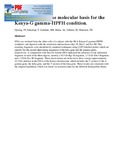| dc.description.abstract | DNA was isolated from the white cells of a subject with the Hb S-Kenya-G gamma-HPFH condition, and digested with the restriction endonucleases Bg1 II, Xba I, and Eco RI. The resulting fragments were identified by standard techniques using [32P] labelled probes which are specific for the second intervening sequences of the beta gene and the gamma genes, respectively. A comparison with data for normal DNA indicated the presence of one additional fragment in each of the three digests, namely a 10.5 kb Bg1 II fragment, a 7.8 kb Xba I fragment, and a 2.9 kb Eco RI fragment. These observations are believed to show a large (approximately 22.5 kb) deletion in the DNA of the Kenya chromosome which includes the 3' section of the A gamma gene, the delta gene, and the 5' section of the beta gene. These results are consistent with the original hypothesis which was based on structural data for the different hemoglobin chains. | en |

